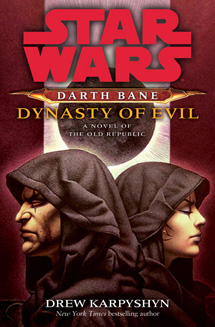Ki Adi-Mundi (in “The Phantom Menace”): “The Sith have been extinct for a millennium.”
Yoda (later in the same movie): “Two there are always, a master and an apprentice.”
The legacy of the Rule of Two — as outlined by Yoda’s statement — is explored in “Star Wars: Darth Bane: Dynasty of Evil” (2009), the third book in a Bane trilogy by Drew Karpyshyn that takes place 1,000 years before the prequels.
The Rule of Two didn’t make much logical sense to me when I first heard about it, and that’s why the exploration of its origins should be fascinating. However, this is case where George Lucas wrote one aspect of his mythology into a corner, and Karpyshyn can’t quite write his way out of it.
When characters discuss the seemingly illogical Rule of Two, I can sense the author trying to work things out for himself. Consider this exchange between Set, a Dark Sider whom Zannah (Bane’s apprentice) is recruiting as a possible apprentice of her own.
Set: “You are the apprentice. You think it’s time to challenge your Master. And you want me to help you defeat him.”
Zannah: “No! That is the old way. Lesser followers would unite their inferior skills to bring down a strong leader, weakening the Order. This goes against everything the Rule of Two stands for. If I am to become the Dark Lord of the Sith, I must prove myself by facing my Master alone. If I am unworthy, then I will fall … but the Order will remain strong under his leadership.”
This makes a certain amount of philosophical, big-picture sense, but it makes no logical sense from the point of view of individual characters. If it gives her a chance to become the Dark Lord, why wouldn’t Zannah enlist Set’s help? Power as the Sith see it isn’t just about physical strength or fighting skills, it’s also about cunning (case in point: Darth Sidious, who proves to be the most successful Sith).
The Sith Order is not stronger because there are only two. If the Jedi could find Bane and Zannah, they could wipe them out, because there are thousands of Jedi and only two Sith.
The reason why Darth Sidious overthrows the Jedi in “Revenge of the Sith” is because he is brilliantly cunning. It isn’t because there are only two Sith. And besides, the “only two” thing is a technicality. While there may only be two “Sith,” there are many more Dark Side-users. They might not call themselves Sith, but so what? The Dark Lord of the Sith still has to look over his or her shoulder for potential threats to his power, and indeed, even the plot of “Dynasty of Evil” is about threats from Zannah, Set and other challengers. Furthermore, what’s to stop these other Dark Siders from labeling themselves Sith and forming an Army of the Sith to overthrow Bane? Nothing. But then, there’s nothing to overthrow, because Bane holds no galactic power; he only reigns over his kingdom of two. He’s little more than a megalomaniac nutjob hermit.

The Rule of Two is 180 degrees removed from (what I thought was) the true nature of the Sith: The selfish desire for power. Even if it is good for the Sith Order as a whole, it makes no sense for Bane personally, or for the majority of the hundreds of Sith that succeed him until Sidious comes along. Essentially, all these guys did for a millennium was master Dark Side skills and hide from the Jedi. That sounds like a good life for a monk, but not for a person who allegedly craves power.
Granted, the idea of “Sith as monk” was introduced in the “Legacy of the Force” books. Darth Caedus learns about Darth Vectivus (one of the line of Sith Lords between Bane and Sidious), who mastered the Sith arts but was not evil.
The problem, though, is that Bane — along with Zannah and Set and 99 percent of the Darths we have met — is not a harmless monk. He’s evil and selfish. He aims to kill all potential threats, even if they are (the closest thing he has to) friends. Yet we are supposed to believe he came up with this Rule of Two, which goes against the principles of evil and is highly unselfish.
These would be good conundrums to explore and unravel if Karpyshyn was up to the task, but I get the sense that the author doesn’t entirely believe in the Rule of Two himself. “Dynasty of Evil” is a safe, simple novel — a personal intrigue between a half-dozen characters. It’s not terrible, but … let’s just say that I had to renew it for an extra two weeks from the library — it’s a bit of a slogger. When it comes to Darth Bane, a name “Star Wars” fans love, Karpyshyn isn’t able to make him pop the way his moniker pops.
Bane is a confused character who doesn’t know he’s confused, and he leaves a confused legacy. Lucas may not have given much thought to the Rule of Two, but this can’t be what he had in mind.

